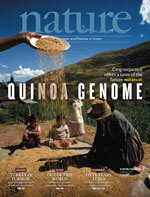 A new genome assembly has remarkable promise to boost the global food supply. Scientists from King Abdullah University of Science and Technology and other institutions sequenced quinoa, a nutritious grain that can grow in marginal lands and other suboptimal environments. Their assembly offers new clues that could help improve breeding efforts to make the plant more accessible worldwide.
A new genome assembly has remarkable promise to boost the global food supply. Scientists from King Abdullah University of Science and Technology and other institutions sequenced quinoa, a nutritious grain that can grow in marginal lands and other suboptimal environments. Their assembly offers new clues that could help improve breeding efforts to make the plant more accessible worldwide.
“The genome of Chenopodium quinoa” was published recently in Nature by lead author David Jarvis, senior author Mark Tester, and a large group of collaborators. They focused on this plant, which is believed to have been domesticated more than 7,000 years ago in South America, because it is rapidly becoming accepted as a superfood with potential to address the growing food supply challenge. Quinoa is a relatively low-sugar, gluten-free grain with lots of nutrients. But expanding its use as a crop around the world requires new breeding efforts, the authors report. They used SMRT Sequencing to generate a high-quality, chromosome-scale genome assembly for the allotetraploid plant, a valuable resource that can now be used by breeding programs to produce shorter, higher-yielding plants with increased stress tolerance and other desirable traits.
The team sequenced a plant from coastal Chile, followed by scaffolding with Bionano Genomics and Dovetail Genomics tools. The assembly is 1.39 Gb, represented in fewer than 3,500 scaffolds. Ninety percent of the genome is covered in just 439 scaffolds. “This assembly represents a substantial improvement over the previously published quinoa draft genome sequence, which contained more than 24,000 scaffolds with 25% missing data,” the scientists report. Iso-Seq analysis and other annotation methods resulted in nearly 45,000 gene models, while a BUSCO analysis found that more than 97% of reported genes were included in the assembly. The group also sequenced two diploids from ancestral quinoa relatives.
One of the most exciting findings from the project was the discovery of a transcription factor that is believed to regulate production of saponins, bitter-tasting molecules in the quinoa shell. A premature stop codon found in sweet quinoa strains suggests that it may be possible to breed these saponins out to produce a plant more amenable for farming.
“These resources provide the foundation for accelerating the genetic improvement of the crop, with the objective of enhancing global food security for a growing world population,” Jarvis et al. write.
March 7, 2017 | General